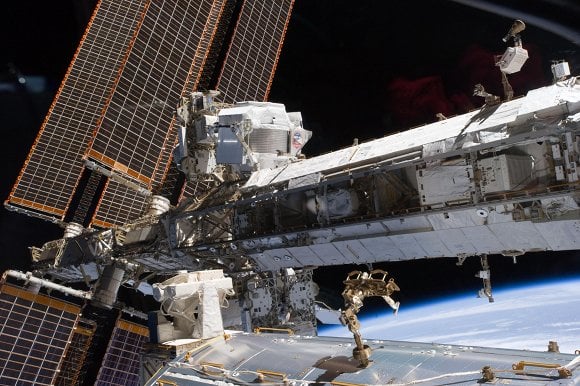This article is more than 1 year old
HAPPY 15th BIRTHDAY, International Space Station! NASA man reveals life on-board
And how orbiting lab's work clears way for Mars trips
The first section of the International Space Station lifted off atop a Russian rocket 15 years ago. Today, NASA says it's confident the habitat is safe to stay in orbit until 2028, and possibly much longer.
"All of the primary structure looks good until 2028," Dan Hartman, deputy program manager for the ISS, told The Register. "We're looking really good for the 2028 time period."
All of the modules of the ISS were initially designed for a 15-year lifespan. But the addition of shielding and upgrades makes even the first section, which lifted off from Baikonur Cosmodrome on November 20 1998, good to go for another 15 years to come, Hartman said.
The ISS free-falls through space at 17,240mph and undergoes intense thermal stresses on the way, as well as trying to maintain pressure and avoid the debris scattered through Earth's orbital sphere. Gradually building the station, module by module, over 15 years and keeping it safe has been a lesson in engineering, but in recent years the task of the ISS has been less about construction and more about science.
"We've ramped up our research now from 15 to 20 hours a week, we targeted 35 hours and we've actually exceeded that, we're now getting easily 45 hours of science work out of the station," Hartman said. "We've done a big phase shift. In the early years it was about getting the thing assembled and now we're turning the keys over for utilization for research."
The ISS is the only lab we have for carrying out sustained scientific research in zero-gravity conditions, and there are now five dedicated modules of the station that are purely for research. So far at least 1,500 scientific studies have been carried out in space, and the results are being used back here on Earth by the 69 countries that have taken part.
However, the astronauts who occupy the ISS are living experiments themselves. We humans have evolved in an environment with a mostly useful gravitation pull; spending long periods in space can cause problems, therefore. But the research opportunity of the ISS means we can now adapt to overcome the disadvantage of a weightless existence.

International Space Station ... 'Nauts install a spectrometer earlier this year (Credit: NASA)
For example, it used to be the case that prolonged exposure to space left astronauts with weaker bones and wasted muscles. Now a combination of better diet and an orbital gym facility that have largely eliminated these problems and, in some cases, visitors to the ISS return to Earth in better shape than when they left it, Hartman said.
There are still some problems to fix however. Fluid build-up in the eyes can cause a weakening of vision, but NASA has developed a fix for the issue to safely start one-year missions to the station in 2015, as opposed to the more normal six-month rotations that are the current norm.
Such long missions will make it possible to send humans safely to Mars, Hartman said, but – as importantly – the ISS is also a proving ground for the technologies required to make such a trip. The last 15 years have seen mini-revolutions in our understanding of how to build the life-support systems for such a trip.
Take water. A gallon of the stuff weighs about eight pounds and lofting it into orbit is an expensive business. Both by harvesting an astronaut's urine, sweat and the moisture in breath, around 80 per cent of the water on the ISS is recycled and reused.
Psychological health is also another factor in space medicine. Astronauts on the ISS have designated private time and can converse with family and friends via a 300Mbps data connection, Hartman said. Each crew member has their own (albeit small) cabin for alone time and can call home if needed.
When Ronald Reagan first directed NASA to build an orbital home for mankind in 1984 he said it should be dedicated to "peaceful, economic, and scientific gain." In its first 15 years the ISS has hit all three targets and looks set to continue for many more years to come. ®
